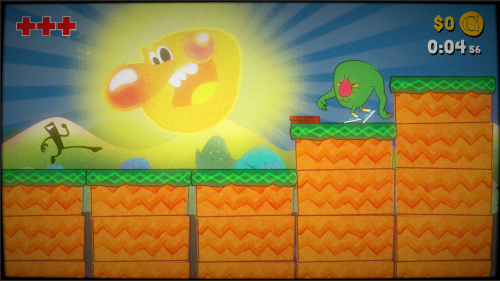
How Runner3 improves on perfection ⊟
The Bit.Trip Runner series demands perfection in a way that many other games don’t. Make a single mistake in one of its auto-scrolling stages – “bonk” – and you’re zipped back to the beginning. Each stage is a gauntlet of obstacles to jump, slide, and kick through, with a line of gold bars tempting you, with each move and item triggering a musical cue.
You can choose to collect all the gold, or not – so, you can play “perfectly” by avoiding every obstacle, or you can play more perfectly by going for the gold. In making sequels to Runner, developer Choice Provisions has had to find ways to increase player choice while maintaining the reactive gameplay, and in the process it’s introduced multiple additional layers of perfection.
Now in Runner3, you can simply complete a level; you can also collect all the gold. After completing a stage once, you can also take an alternate path for gems. Some stages have branches that lead to a “Hero Quest,” where some monstrous cartoon weirdo will ask for items hidden within other stages, so you can go back and find those. Hidden items also unlock “Retro Challenges,” which offer in-game currency you can trade for cosmetic items – collecting all the costumes, capes, and accessories is another totally optional goal. On top of that, there are bonus “Impossible” levels, which may not actually be impossible but I ain’t going to finish any of them.
I’ve been thinking about this a lot, for years, ever since Runner2 introduced branching paths. I’m fascinated how, in the process of demanding a mistake-free performance, Runner somehow gives you permission to make unlimited mistakes, and even expects them. “Bonking” is inevitable, and each bonk adds to your growing muscle memory of a stage, so bonk away. Because the game is so exacting, failed runs seem less like failures, and more like studying. I will note, though, that Runner3 shows you how many times you’ve bonked at the beginning of every attempt. This will hurt you.

Runner3 adds to player choice not just in terms of these additional goals to seek or ignore, but also in moment-to-moment gameplay. The controls are much less rigid than before, thanks to the new double-jump and slide move. It’s now possible to fine-tune a jump even if it’s executed imperfectly, and to double-jump even when it’s unnecessary. It pushes Runner even further into the weird limbo it occupies between platforming and rhythm game, and makes play feel less like reacting and a little more like performing. Some stages allow CommanderVideo to pilot a plane, drive a car, or operate a more… miscellaneous vehicle, and some stages even change perspective from the formerly rigid side-view. In both cases, analog movement is possible, which feels super weird for this exacting game, but somehow works, allowing even more of a personal touch from the player. Additional “retro” levels even allow for full movement left or right.
The experimentation worked. For me, Runner3 is the most enjoyable game in the series, standardizing stage length, adding weirder jokes (many delivered in a virtuoso performance by Charles Martinet), and improving in many ways on the first game – which I already considered “perfect.”
JOIN CLUB TINY AND OUR DISCORD Support Tiny Cartridge!
